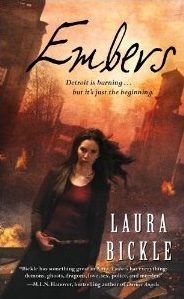I picked up Laura Bickle’s debut novel, Embers, without undue expectations. In the course of my various review columns, I read a lot of urban fantasy, and to be frank–as with any booming subgenre–a great deal of it is somewhat mediocre.
Embers, however, proved one of the most promising debut novels I’ve read in a great while. Bickle gives us a strong and interesting—but vulnerable and believable–protagonist in Motor City arson investigator Anya Kalinczyk—who also happens to be a “Lantern,” a sort of medium psychically linked to fire elementals and fire. One of my biggest complaints about urban fantasy is the preponderance of authors who seem to confuse “kickass” heroines with brittle, mouthy, neurotic creeps who make most of their own problems.
By contrast, Anya is smart, self-aware, competent, and fun. She had her issues (including a bit of heavyhanded, Gremlinsesque backstory that was my least favorite thing about the book, alas) and her strengths, but more importantly she has functioning and complex relationships with a wide range of people: friends, colleagues, ghosts, a wonderful salamander-like familiar called a hellbender, and a romantic interest who didn’t bore me.
The choice of Detroit as a location for the action turns out to be thematically fortuitous, given the Motor City’s current fiscal and cultural woes. Because this is a story about flame, the archetypal engine of destruction and rebirth, its phoenix imagery emerges organically from the setting. In addition, Detroit’s well-known relationship with fire (the book takes place over the days leading up to Devil’s Night) makes for powerful subtext.
That’s all beautifully done, and the lovingly doled-out tidbits of Detroit history and description that salt the novel give a great sense of place. They also establish the protagonist’s complicated love of her brutalized city in a subtle and effective fashion.
That complication carries over into her relationship with the antagonist, who is in himself—beautiful, noble, and brutalized into corruption—a metaphor for the city he inhabits and intends to destroy. The book’s central question—is there anything you can do to repair something so ruined, or is it better to burn it and start over?—is one that is dear to my own heart as a writer, and I felt that this book hit all the right notes in asking those questions.
As charismatic as the bits of local color are, they’re not the only touches I found charming. I was delighted by the author’s treatment of religion—it felt very natural and intrinsic to the characters who professed or resisted it. And I tend to agree that Ishtar was a badass, so that element of the plot delighted me. I did feel like Anya took just a little too long to figure out the antagonist’s wicked plan, which was transparent to me from about a third of the way through the book, but in all honesty I would have put up with a lot more straightforward plotting when the payoff is Anya’s big dress shopping scene.
Now, I’m a bit of a tomboy, and not what you would call a big fan of dress shopping—but that particular scene made the entire middle of the book for me.
Sadly, this does not mean the book is entirely devoid of first-novel problems. While the writing is in large part strong, there is some awkwardness and repetitive phrasing, and I did feel that the climax of the book was dispensed with in an overly rushed and arbitrary fashion that did not require adequate action on the part of the protagonist. Still, the endings of novels—especially early novels—are often their weakest point, and my complaints in this regard are still quite moderate.
Overall, I’d highly recommend this book to anybody who reads fantasy. It reminds me in many regards (in its weaknesses as well as in its strengths) of another exceptional first novel set in the upper Midwest, Emma Bull’s seminal War for the Oaks, and there’s not much higher praise that I can give.
Elizabeth Bear writes urban fantasy sometimes too, and she really wishes she’d thought of the hellbender thingy first.










